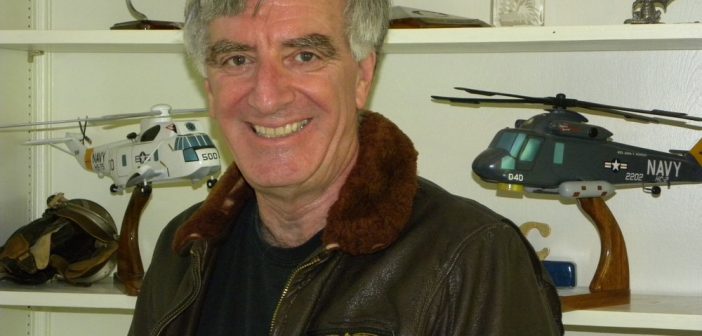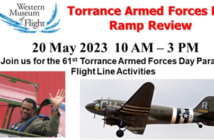For many years after World War II, the Air Force didn’t allow its pilots to wear the fleece-lined jackets or the brown leather flight jackets that were issued during the war. My dad’s hung in the closet and he wore the fleece lined one when it was cold and the summer one, in the spring and fall.
Disappearance of the flight jackets became a major bone of contention between my parents, when my mother threw them both out; dad was away on temporary duty, and she did her spring-cleaning. Eventually they would laugh about it, but my dad really never forgave her for tossing the two jackets out. Today, if we still had them, their intrinsic value would be off the charts, but alas, that is not to be.
In the 1980s, the Air Force approved a brown dark leather flight jacket that was similar to those issued during World War II. Immediately, my dad bought one, found the right patches and had them sewn on the jacket. Under the Command Pilot Wings it said, S. Liebman, LTC USAF (retired).
For those of you who are not Naval Aviators, our brown leather flight jackets with their fur collars are valued because of the history they represent. At the time this article was written, I still have my original jacket issued to me in June 1968 and it still fits. Well, it is a bit tight, but I can get it zipped up. The original cuffs were replaced, but it is still the same jacket with the original fur collar. And, it has the smells from thousands of hours of being confined in a survival vest and strapped into a seat.
From the time they were little children, my son and daughter knew that their Dad’s leather flight jacket was something they didn’t play with. My wife who heard the story about the fate of my Dad’s flight jackets, made sure never to throw it out.
My brother Scott lobbied to be given my dad’s new leather flight jacket after he passed away. The short answer was “no”. The longer answer included a statement: “You have to earn or be issued one. That means you have to have been in a service that gives them to aircrews.”
Scott persisted and kept asking so often that it became a family joke. Part of his argument was that since his first name begins with an S, the nametag could be either Sy (my dad’s first name) or Scott.
Every summer after our children reached the ripe old age of eight, they would fly to New York or to Fort Lauderdale for one-on-one time with their grandfather. When Seth was about ten years old, I took him flying for the first time. From that day on my son wanted to be a Naval Aviator He and my dad would often talk about what it was like to fly before and after World War II.
Unfortunately, my father was a lifelong smoker despite my mother’s urging to quit and he ultimately paid the price for the addiction. At times, he stopped, but after my mother died, his second wife was a smoker and he was back to a pack a day. Lung cancer didn’t kill him. Hardening of the arteries did. In the end, the vessels that carried blood throughout his body no longer were able to support his organs or deliver sufficient blood to his brain. At age 72, my dad had a stroke.
It didn’t paralyze him or affect his speech, but my brother and I could see it took a lot out of him. He’d been splitting time between his house in Northport, NY and his condominium in Fort Lauderdale. By then, his second wife had passed away and we nursed him back to health, or we thought we did. Thinking everything was O.K., we sent my 19 year-old daughter down to spend a few weeks with him in Florida. After she came back, Scott went down for a week and was relieved by Seth who would be relieved by me.
A few days after Seth arrived, my dad had a stroke and my fifteen year-old son knew enough about first aid to save his life, get an ambulance to the condominium and him to a hospital. Scott and I arrived the next day and the prognosis was not good. Seth stayed for a few days before I sent him home.
We were told by the doctors that our father’s organs were starting to fail because they weren’t getting enough blood. His heart was working overtime to pump blood and either his organs would die or he would have a massive heart attack. It wasn’t a matter of months, but days or weeks.
Dad, the World War II and Korean War combat veteran, was going downhill fast but the body and the mind don’t give up life easily. He was in a hospital room with tubes plugged into his arms and Scott and I stayed by the bedside as our dad drifted in and out of consciousness. It was a scene I hope never to have to put my family through.
When he was conscious, we tried to talk to him, but it was difficult because he was often not coherent and we believed he knew he was dying. One afternoon, in a moment of lucidity when Scott and I were standing by the bed, he squeezed our hands and looked at Scott and then at me and said, “Seth gets my flight jacket. Make sure of it.”
He closed his eyes and slipped back into unconsciousness. That evening he died and those were the last words my father ever said.
After the funeral, I told Seth the story and gave him the jacket on the condition that he would wear it only after he was designated a Naval Aviator. He earned his wings in 2002 and flew F/A-18s on active duty. Today, the jacket is in Seth’s closet and he wears it proudly. I hope that one day, he’ll pass it on to one of his children.
© Marc Liebman, March 2018, all rights reserved




